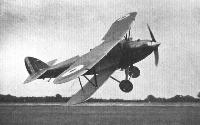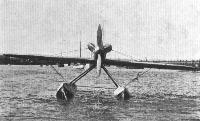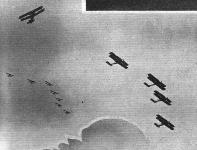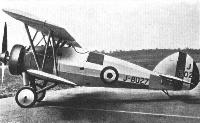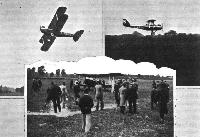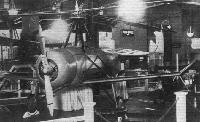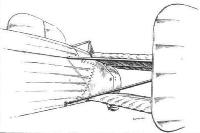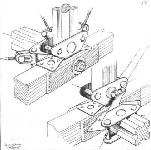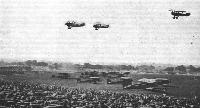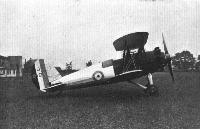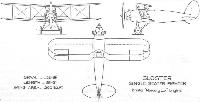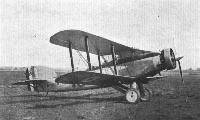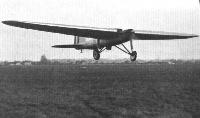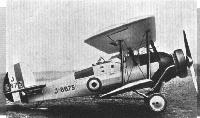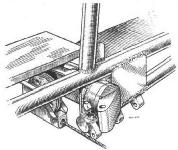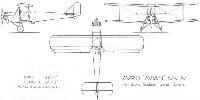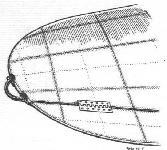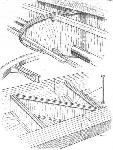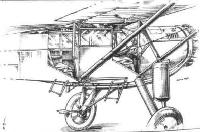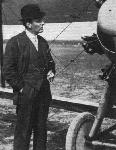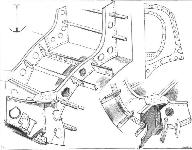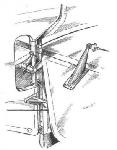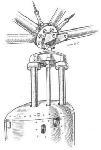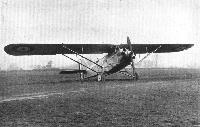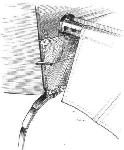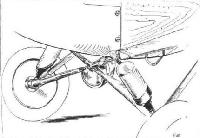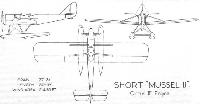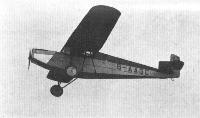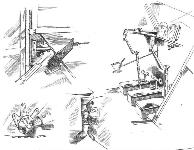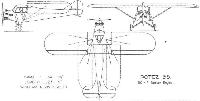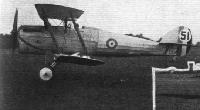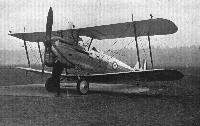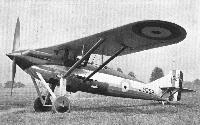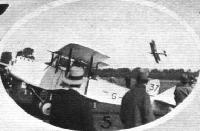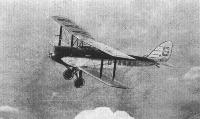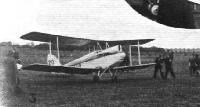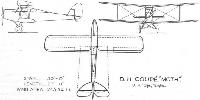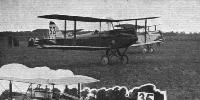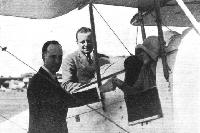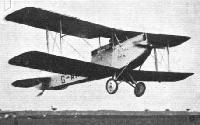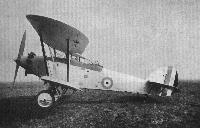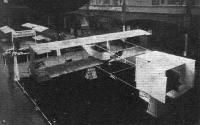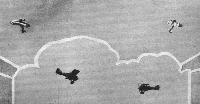Фотографии
-
SHADES OF OLYMPUS! Example of early aircraft exhibited at previous Olympia Aero Shows. The Bristol Scout (80-h.p. Gnome) of 1914, perhaps the first of the modern, highspeed Military machines. It played an important part in the Great War which opened that same year.
Самолёты на фотографии: Bristol Scout - Великобритания - 1914
-
Регистрационный номер: SE-ABW, S-AABW Junkers K.47 low-wing monoplane with twin tail (Bristol "Jupiter" engine) on which Herr W. Neuenhofen won third place and ?20 in the International Aerobatic Competition.
Самолёты на фотографии: Junkers K 47 / A 48 - Германия - 1928
-
The Hawker Stand has the distinction of exhibiting three machines never hitherto seen in public: The "Tomtit" training machine, the "Hart" day bomber recently ordered in quantities for the R.A.F., and the "Hornet," believed to be the world's fastest single-seater fighter.
Самолёты на фотографии: Hawker Hart - Великобритания - 1928Hawker Hornet / F.20/27 - Великобритания - 1928Hawker Tomtit - Великобритания - 1928
-
Регистрационный номер: J9052 HAWKER "HART" (Rolls-Royce "F").
Самолёты на фотографии: Hawker Hart - Великобритания - 1928
-
Hawker "Hart" Rolls-Royce F XI Engine
Самолёты на фотографии: Hawker Hart - Великобритания - 1928
-
Регистрационный номер: VH-USU ACCOMPLISHED! Southern Cross monoplane makes the final landing of the Australia-England flight at Croydon, July 10, 1929.
Самолёты на фотографии: Fokker F.VII / C-2 / F.XIV - Нидерланды - 1924
-
Самолёты на фотографии: Fokker F.VII / C-2 / F.XIV - Нидерланды - 1924
-
DISTINGUISHED VISITORS AT FILTON: On July 17 the Bristol Aeroplane and aero engine works were visited by the Infante of Spain and M. Robert Esnault Pelterie, one of the pioneers of French aviation. The Infante, who is one of the finest Spanish pilots, made a flight in a Bristol "Bulldog," and made a perfect three-point landing. In the photograph are seen, on the right, from left to right: Don Alfonso, Senor Carlos de Quiros, Mr. C. F. Uwins, and M. Robert Esnault Pelterie.
Самолёты на фотографии: Bristol Bulldog - Великобритания - 1927
-
EVENT 9. LOW ATTACKS: A demonstration of low attacks was given by Day Bomber and Fighter Squadrons. Here are seen three Bristol Bulldogs of No. 3 Fighter Squadron
Самолёты на фотографии: Bristol Bulldog - Великобритания - 1927
-
The Bristol Stands: On the aircraft stand in the foreground may be seen the 110A passenger machine, and behind that the "Bulldog" single-seater fighter. In the background the engine stand.
Самолёты на фотографии: Bristol Bristol 110 - Великобритания - 1929Bristol Bulldog - Великобритания - 1927
-
AIRCRAFT IN THE KING'S CUP: Bristol "Bulldog" (490-h.p. Bristol "Jupiter VIa ").
Самолёты на фотографии: Bristol Bulldog - Великобритания - 1927
-
Bristol "Bulldog" Bristol "Jupiter VII" Engine
Самолёты на фотографии: Bristol Bulldog - Великобритания - 1927
-
TENTH R.A.F. DISPLAY. EVENT 3: PARACHUTE DESCENTS: A thrilling demonstration by the Parachute Section of the Home Aircraft Depot. Above, six airmen are seen leaving the three Vickers Vimy machines. Below, they are nearing the ground; the two on the left collided, and one released another, emergency, 'chute (which can be seen opening) and thus avoided an accident.
Самолёты на фотографии: Vickers Vimy / FB.27 - Великобритания - 1917
-
Регистрационный номер: F9569 VICKERS "VIMY": Training Bomber, with two Napier "Lions" (other engines also fitted).
Самолёты на фотографии: Vickers Vimy / FB.27 - Великобритания - 1917
-
AIRCRAFT IN THE KING'S CUP: S.E.5A (120-h.p. "Airdisco" and 200-h.p. "Viper").
Самолёты на фотографии: RAF S.E.5 - Великобритания - 1916
-
Регистрационный номер: J6586 IN THE DISPLAY: Although a War Veteran, the Bristol Fighter, modernised and fitted with slots, is still seeing service in the R.A.F.
Самолёты на фотографии: Bristol F.2A/F.2B Fighter - Великобритания - 1916
-
Регистрационный номер: N220 [2] A SCHNEIDER TROPHY MEMENTO: During a visit to Olympia, Flt.-Lieut. S. N. Webster was presented with a Souvenir Album of the 1927 Schneider Trophy Contest - which he won. Our picture shows him, beneath the "S.5", with Mr. H. T. Vane of Napiers (left) and Comdr. Bird of Supermarine Aviation Works, Ltd. (right).
Самолёты на фотографии: Supermarine S.5 / S.6 - Великобритания - 1927
-
SUPERMARINE "S.5" (Napier Racing Engine).
Самолёты на фотографии: Supermarine S.5 / S.6 - Великобритания - 1927
-
Регистрационный номер: N220 [2] The Supermarine Machines: In the foreground the S.5 racing seaplane mounted in a very effective attitude. Behind it the "Southampton" flying-boat, which has made a flight of 27,000 miles.
Самолёты на фотографии: Supermarine S.5 / S.6 - Великобритания - 1927Supermarine Southampton / Solent - Великобритания - 1925
-
Supermarine S.5 Napier "Lion X" Engine
Самолёты на фотографии: Supermarine S.5 / S.6 - Великобритания - 1927
-
IN FULL FLIGHT: The Dornier Do. X photographed from another aeroplane flying over Lake Constance
Самолёты на фотографии: Dornier Do.X - Германия - 1929
-
LAUNCHING THE WORLD'S LARGEST FLYING-BOAT: The 12-engined Dornier Do. X leaving its slipway. Scale is given to the picture by the people standing on the lower wing roots.
Самолёты на фотографии: Dornier Do.X - Германия - 1929
-
THE GIANT OF THE AIR: Unable to exhibit the actual machine, the Dornier firm is showing a scale model of the Do.X. This photograph, taken in the Dornier Works, shows the actual machine, and gives an excellent idea of the size.
Самолёты на фотографии: Dornier Do.X - Германия - 1929
-
THE FIRST FLIGHT: The Dornier Do. X leaving the water for the first time.
Самолёты на фотографии: Dornier Do.X - Германия - 1929
-
JUST BEFORE THE LAUNCH: The Dornier Do. X on the slipway. Note the tandem arrangement of the "Jupiter" engines.
Самолёты на фотографии: Dornier Do.X - Германия - 1929
-
EVENT 1: EVOLUTIONS BY THREE FIGHTER SQUADRONS: The "Spiralling Snake." One Squadron of Siskins has flown out of our picture!
Самолёты на фотографии: Armstrong Whitworth Siskin - Великобритания - 1921
-
EVENT 1: EVOLUTIONS BY THREE FIGHTER SQUADRONS: Twenty-Seven Siskins of Nos. 1, 25, and 43 Squadrons "left-wheel" in Flights Astern.
Самолёты на фотографии: Armstrong Whitworth Siskin - Великобритания - 1921
-
EVENT 5: ATTACK ON AN ENCAMPMENT: No. 41 Squadron (Siskins) diving on the camp, firing at the same time their machine guns.
Самолёты на фотографии: Armstrong Whitworth Siskin - Великобритания - 1921
-
EVENT 1: EVOLUTIONS BY THREE FIGHTER SQUADRONS: Two of the three squadrons of Siskins, in Mass Line Abreast, form a total eclipse.
Самолёты на фотографии: Armstrong Whitworth Siskin - Великобритания - 1921
-
EVENT 14: AIR BATTLE AND SET PIECE: (3) British Heavy Bombers arrive, followed by attacking enemy fighters ("Siskinskys").
Самолёты на фотографии: Armstrong Whitworth Siskin - Великобритания - 1921Handley Page Hyderabad/H.P.24 / Hinaidi/H.P.33 / Clive/H.P.35 - Великобритания - 1923
-
Some of the Armstrong Whitworth machines: On the left the A.W.14, on the right the "Atlas," and behind them the "Siskin." Note that all are fitted with the "Townend ring."
Самолёты на фотографии: Armstrong Whitworth Atlas / Ajax - Великобритания - 1925Armstrong Whitworth Siskin - Великобритания - 1921Armstrong Whitworth Starling / A.W.14 - Великобритания - 1927
-
Регистрационный номер: J8027 ARMSTRONG WHITWORTH "A.W. XIV" (Armstrong Siddeley "Jaguar").
Самолёты на фотографии: Armstrong Whitworth Starling / A.W.14 - Великобритания - 1927
-
Among the firms who have done a lot of experimental work with the "Townend ring" is Sir W. G. Armstrong-Whitworth Aircraft, Ltd., whose A.W. XIV is shown
Самолёты на фотографии: Armstrong Whitworth Starling / A.W.14 - Великобритания - 1927
-
Armstrong Whitworth A.W.14 Armstrong Siddeley "Jaguar" Engine
Самолёты на фотографии: Armstrong Whitworth Starling / A.W.14 - Великобритания - 1927
-
ARMSTRONG WHITWORTH "ARGOSY" (3 Armstrong Siddeley "Jaguar").
Самолёты на фотографии: Armstrong Whitworth Argosy - Великобритания - 1926
-
A typical fuselage joint and wing root attachment on the "Argosy" Passenger Aeroplane.
Самолёты на фотографии: Armstrong Whitworth Argosy - Великобритания - 1926
-
Attachment of undercarriage strut to lower plane on the "Argosy" Passenger Aeroplane.
Самолёты на фотографии: Armstrong Whitworth Argosy - Великобритания - 1926
-
The axles on the "Argosy" are hinged by means of universal joints.
Самолёты на фотографии: Armstrong Whitworth Argosy - Великобритания - 1926
-
Armstrong-Whitworth "Argosy" Armstrong Siddeley "Jaguar" Engines
Самолёты на фотографии: Armstrong Whitworth Argosy - Великобритания - 1926
-
Регистрационный номер: G-EBXK WESTLAND LIMOUSINE (3 A.D.C. "Hermes").
Самолёты на фотографии: Westland Wessex / Westland IV - Великобритания - 1929
-
Регистрационный номер: G-AAGW The Westland Stand nearly defied our photographer, as no viewpoint could be found which would show the limousine, the "Wapiti" and the "Widgeon."
Самолёты на фотографии: Westland Wapiti - Великобритания - 1927Westland Wessex / Westland IV - Великобритания - 1929Westland Widgeon - Великобритания - 1924
-
IN the cabin of the "Westland IV" - three-engined limousine some of the passengers face forward and some aft. A door in the forward wall gives access to the pilot's cockpit.
Самолёты на фотографии: Westland Wessex / Westland IV - Великобритания - 1929
-
On the Westland Limousine the rear fuselage portion is of square tube construction. Rubber buffers are used in the suspension of the petrol tank in the wing.
Самолёты на фотографии: Westland Wessex / Westland IV - Великобритания - 1929
-
Westland IV Limousine 3 Cirrus "Hermes" Engines
Самолёты на фотографии: Westland Wessex / Westland IV - Великобритания - 1929
-
Регистрационный номер: G-EBPQ SECOND AND ALSO FIRST: Lieut. L. G. Richardson, second in the King's Cup and first in the Siddeley Trophy, starting from Heston (left) and finishing. Below, Richardson and Atcherley being greeted on landing at Heston.
Самолёты на фотографии: De Havilland Moth / D.H.60 - Великобритания - 1925
-
AIRCRAFT IN THE KING'S CUP: D.H. "Moth X" (75-h.p. "Cirrus II").
Самолёты на фотографии: De Havilland Moth / D.H.60 - Великобритания - 1925
-
Регистрационный номер: G-AAHP FIRST TWICE, NOW THIRD: Last year's winner, Capt. W. L. Hope, seen on the right, looks far from displeased, although he came in third for the King's Cup and second for the Siddeley Trophy. On the left, starting from Heston.
Самолёты на фотографии: De Havilland Moth / D.H.60 - Великобритания - 1925
-
A NEW BRITISH TWO-SEATER "NOT-SO-LIGHT 'PLANE": The Parnall "Elf," fitted with " Cirrus-Hermes" engine, will be exhibited at Olympia. Note the Warren Girder wing bracing.
Самолёты на фотографии: Parnall Elf - Великобритания - 1929
-
On the Parnall Stand: In the foreground the "Peto" seaplane designed to work with submarines. Behind it the "Elf" two-seater civilian machine.
Самолёты на фотографии: Parnall Elf - Великобритания - 1929Parnall Peto - Великобритания - 1925
-
View from above into cockpit of "Elf," showing lower end of joystick and aileron cranks.
Самолёты на фотографии: Parnall Elf - Великобритания - 1929
-
The tail skid of the Parnall "Elf" is a laminated steel spring with replaceable cast-iron shoe.
Самолёты на фотографии: Parnall Elf - Великобритания - 1929
-
Attachment of wood ribs to torque tube in "Elf" ailerons.
Самолёты на фотографии: Parnall Elf - Великобритания - 1929
-
The ailerons in the "Elf" are operated by crank levers and external tubes, the flaps having torque tubes and cranks.
Самолёты на фотографии: Parnall Elf - Великобритания - 1929
-
The Interplane struts on the Parnall "Elf" are arranged as a Warren girder. Sketches show strut ends and fittings.
Самолёты на фотографии: Parnall Elf - Великобритания - 1929
-
A hinged lever, normally folded flat against the spar, holds the folded "Elf" wing in place against the fuselage.
Самолёты на фотографии: Parnall Elf - Великобритания - 1929
-
Parnall "Elf" A.D.C. "Hermes" Engine
Самолёты на фотографии: Parnall Elf - Великобритания - 1929
-
Регистрационный номер: N182 PARNALL "PETO" (A.S. "Mongoose").
Самолёты на фотографии: Parnall Peto - Великобритания - 1925
-
Side elevation of "Peto" with wings folded.
Самолёты на фотографии: Parnall Peto - Великобритания - 1925
-
Parnall "Peto" Bristol "Lucifer" Engine
Самолёты на фотографии: Parnall Peto - Великобритания - 1925
-
Регистрационный номер: G-EBTE The "Pobjoy Imp": A Parnall 2-seater light biplane, equipped with the 60 h.p. Pobjoy engine, with which an air speed of 100 m.p.h. is obtained. Parts of the Pobjoy engine (which has previously been described in "Flight") are being made by A.C. (Acedes) Cars, Ltd.!
Самолёты на фотографии: Parnall Imp - Великобритания - 1927
-
Регистрационный номер: SE-ABP, D-1252, S-AABP Junkers' General Purpose Monoplane (two "Jupiters") in a vertical bank over Heston on Saturday piloted by Lieut. O'Konnor.
Самолёты на фотографии: Junkers S 36 / K 37 - Германия - 1927
-
The Cierva "Autogiro": Fitted with an Armstrong-Siddeley "Genet" engine in an American type of cowling, this rotating wing machine is a two-seater light 'plane.
Самолёты на фотографии: Cierva/Avro C.19 - Великобритания - 1929
-
The biplane tail on the Cierva "Autogiro." By tilting the horizontal surfaces upwards they can be made to act as deflectors, and thus assist in starting the rotor.
Самолёты на фотографии: Cierva/Avro C.19 - Великобритания - 1929
-
Cierva Autogiro C.19 Armstrong Siddeley "Genet" Engine
Самолёты на фотографии: Cierva/Avro C.19 - Великобритания - 1929
-
Регистрационный номер: G-AAFN AIRCRAFT IN THE KING'S CUP: Westland "Widgeon III" (75-h.p. "Cirrus II").
Самолёты на фотографии: Westland Widgeon - Великобритания - 1924
-
GETTING THEM DOWN AT WAALHAVEN: Various styles of landing over the tape are shown. 2. Cazalet on "Cirrus-Widgeon."
Самолёты на фотографии: Westland Widgeon - Великобритания - 1924
-
Регистрационный номер: G-EBRQ [2] AIRCRAFT IN THE KING'S CUP: Westland "Widgeon III" (85-h.p. Siddeley "Genet").
Самолёты на фотографии: Westland Widgeon - Великобритания - 1924
-
Регистрационный номер: G-AADE WESTLAND "WIDGEON" ("Cirrus III").
Самолёты на фотографии: Westland Widgeon - Великобритания - 1924
-
AIRCRAFT IN THE KING'S CUP: Westland "Widgeon III" (85-h.p. "Gipsy").
Самолёты на фотографии: Westland Widgeon - Великобритания - 1924
-
Регистрационный номер: G-EBQN, G-EBRQ [2] HULLO, TWINS!: F./O. G. Thorne on the Avro "Avian I" ("Cirrus II") and "J. Wellworth" on the Westland "Widgeon III" ("Genet"), who started together, flew the course together, and finished together!
Самолёты на фотографии: Avro Avian / Type 594/616 - Великобритания - 1926Westland Widgeon - Великобритания - 1924
-
Westland "Widgeon IIIA" Cirrus III Engine
Самолёты на фотографии: Westland Widgeon - Великобритания - 1924
-
Регистрационный номер: J9176 BOULTON & PAUL "SIDESTRAND" (2 Bristol "Jupiters")
Самолёты на фотографии: Boulton Paul Sidestrand / P.29 - Великобритания - 1926
-
BOULTON AND PAUL "SIDESTRAND": High-performance bomber, with two Bristol "Jupiters."
Самолёты на фотографии: Boulton Paul Sidestrand / P.29 - Великобритания - 1926
-
Main structure of metal interplane strut as used on the "Sidestrand." A fairing completes the strut.
Самолёты на фотографии: Boulton Paul Sidestrand / P.29 - Великобритания - 1926
-
New cowling and air intake arrangement on "Sidestrand." Note the oil cooler on top of the fairing.
Самолёты на фотографии: Boulton Paul Sidestrand / P.29 - Великобритания - 1926
-
Main wing spars and interplane strut attachment thereto on the "Sidestrand."
Самолёты на фотографии: Boulton Paul Sidestrand / P.29 - Великобритания - 1926
-
Boulton & Paul "Sidestrand" 2 Bristol "Jupiter VIII" Engines
Самолёты на фотографии: Boulton Paul Sidestrand / P.29 - Великобритания - 1926
-
Регистрационный номер: G-AAIT The Boulton & Paul "Phoenix" exhibited at Olympia is of wood construction, but the production machines will be all-metal.
Самолёты на фотографии: Boulton Paul Phoenix / P.41 - Великобритания - 1929
-
The Boulton and Paul "Phoenix" has an unusual tail arrangement whereby the rudder is identical with each elevator flap. This reduces the number of spares.
Самолёты на фотографии: Boulton Paul Phoenix / P.41 - Великобритания - 1929
-
FAIREY "FIREFLY II" (Rolls-Royce "F").
Самолёты на фотографии: Fairey Firefly - Великобритания - 1925
-
FAIREY S.S. FIGHTER SHIPPLANE (Rolls-Royce "F")
Самолёты на фотографии: Fairey Firefly - Великобритания - 1925
-
BLACKBURN "RIPON" (Napier "Lion").
Самолёты на фотографии: Blackburn Ripon / T.5 - Великобритания - 1926
-
Fuselage fittings for wooden longerons on Blackburn "Ripon II."
Самолёты на фотографии: Blackburn Ripon / T.5 - Великобритания - 1926
-
DAY AND NIGHT: Three of the Fairey Fox Day Bombers, taking part in Event 9, fly over the Handley Page Hyderabad and Vickers Virginia Night Bombers waiting to take off in Event 10.
Самолёты на фотографии: Fairey Fox - Великобритания - 1925Handley Page Hyderabad/H.P.24 / Hinaidi/H.P.33 / Clive/H.P.35 - Великобритания - 1923
-
EVENT 9. LOW ATTACKS: A demonstration of low attacks was given by Day Bomber and Fighter Squadrons. Here are seen three Fairey Foxes of No. 12 Bomber Squadron.
Самолёты на фотографии: Fairey Fox - Великобритания - 1925
-
Fairey "Fox" Rolls-Royce F XI Engine
Самолёты на фотографии: Fairey Fox - Великобритания - 1925
-
Регистрационный номер: J9125 GLOSTER S.S. FIGHTER (Bristol "Mercury IIa").
Самолёты на фотографии: Gloster Gauntlet - Великобритания - 1929
-
Gloster Single Seater Fighter Bristol "Mercury IIA" Engine
Самолёты на фотографии: Gloster Gauntlet - Великобритания - 1929
-
Регистрационный номер: J9237 WESTLAND "WAPITI" (Bristol "Jupiter").
Самолёты на фотографии: Westland Wapiti - Великобритания - 1927
-
Duralumin wing construction on the Westland "Wapiti," showing spar, rib, leading and trailing edge.
Самолёты на фотографии: Westland Wapiti - Великобритания - 1927
-
The latest type of undercarriage for the Westland "Wapiti" is of the split type, with oleo legs.
Самолёты на фотографии: Westland Wapiti - Великобритания - 1927
-
Support of flooring in the Westland "Wapiti." Note also square tube fuselage construction.
Самолёты на фотографии: Westland Wapiti - Великобритания - 1927
-
Westland "Wapiti" Mk.IIA Bristol "Jupiter" VIII Engine
Самолёты на фотографии: Westland Wapiti - Великобритания - 1927
-
"FORMATING" AT ROTTERDAM: Capt. Versteegh's squadron forming up for their display
Самолёты на фотографии: Fokker C.V / C.VI - Нидерланды - 1924
-
Регистрационный номер: J9154 FAIREY III F GENERAL PURPOSE (A.S. "Jaguar")
Самолёты на фотографии: Fairey Gordon / Seal - Великобритания - 1931
-
THE VICKERS VILDEBEEST: A two-seater Torpedoplane with Bristol Jupiter VIII Engine.
Самолёты на фотографии: Vickers Vildebeest / Type 132 - Великобритания - 1928
-
THE KLEMM-SALMSON LIGHT 'PLANE: This machine is exhibited on the stand of S. T. Lea.
Самолёты на фотографии: Klemm L.25 - L.28 Swallow - Германия - 1927
-
GETTING THEM DOWN AT WAALHAVEN: Various styles of landing over the tape are shown. 1. Bos on Klemm-Salmson.
Самолёты на фотографии: Klemm L.25 - L.28 Swallow - Германия - 1927
-
The Klemm-Salmson monoplane is exhibited on the stand of S. T. Lea, who holds the British rights for this machine.
Самолёты на фотографии: Klemm L.25 - L.28 Swallow - Германия - 1927
-
The shock absorbers are housed in the wing of the Klemm-Salmson.
Самолёты на фотографии: Klemm L.25 - L.28 Swallow - Германия - 1927
-
On the Handley Page Stand: In the foreground the fuselage of the 40-passenger machine. Behind that the "Hinaidi."
Самолёты на фотографии: Handley Page H.P.42 / H.P.45 - Великобритания - 1930Handley Page Hyderabad/H.P.24 / Hinaidi/H.P.33 / Clive/H.P.35 - Великобритания - 1923
-
An Artist's Impression of the saloon of the Handley Page four-engined machine. View looking forward.
Самолёты на фотографии: Handley Page H.P.42 / H.P.45 - Великобритания - 1930
-
FEW visitors to Olympia realise that the cabin of the large Handley Page four-engined machine is but an elaborate "mock-up," the actual all-metal fuselage not being ready for the Show. This view shows the cabin, bar, etc.
Самолёты на фотографии: Handley Page H.P.42 / H.P.45 - Великобритания - 1930
-
A scale model of the Handley Page four-engined 40-passenger aeroplane.
Самолёты на фотографии: Handley Page H.P.42 / H.P.45 - Великобритания - 1930
-
Регистрационный номер: G-EBHP HANDLEY PAGE 4-ENG. COMMERCIAL (4 Radial air-cooled).
Самолёты на фотографии: Handley Page H.P.42 / H.P.45 - Великобритания - 1930
-
Регистрационный номер: J9479 [2] The Fairey Stand is one of the most impressive individual exhibits at the Show. Note the long-distance monoplane mounted on the roof of the office.
Самолёты на фотографии: Fairey Long-Range Monoplane - Великобритания - 1928
-
Регистрационный номер: J9479 [2] FAIREY LONG-DISTANCE MONOPLANE (Napier "Lion")
Самолёты на фотографии: Fairey Long-Range Monoplane - Великобритания - 1928
-
Fairey Long Range Monoplane Napier "Lion" Engine
Самолёты на фотографии: Fairey Long-Range Monoplane - Великобритания - 1928
-
Регистрационный номер: G-EBUP, N179 SHORT "SINGAPORE I" (2 Rolls-Royce "H.10").
Самолёты на фотографии: Short Singapore I / S.5 - Великобритания - 1926
-
The Short "Singapore" is the machine on which Sir Alan Cobham flew to the Cape and back. A "Mussel" and an amphibian "Moth" are also exhibited.
Самолёты на фотографии: De Havilland Moth Seaplane - Великобритания - 1926Short Mussel / S.7 - Великобритания - 1926Short Singapore I / S.5 - Великобритания - 1926
-
The Short "Singapore" hull construction uses channel and L-section frames. The longitudinal stringers are interrupted at the frames.
Самолёты на фотографии: Short Singapore I / S.5 - Великобритания - 1926
-
ON THE SHORT "SINGAPORE": Details of the duralumin box spars, strut fittings and a strut end. Note laminated spar flanges.
Самолёты на фотографии: Short Singapore I / S.5 - Великобритания - 1926
-
Short "Singapore" 2 Rolls-Royce H.10 Engines
Самолёты на фотографии: Short Singapore I / S.5 - Великобритания - 1926
-
ARMSTRONG-WHITWORTH "ATLAS": Army Co-operation 'plane with Armstrong Siddeley "Jaguar."
Самолёты на фотографии: Armstrong Whitworth Atlas / Ajax - Великобритания - 1925
-
EVENT 7. MESSAGE PICKING UP: Three Armstrong-Whitworth Atlas machines of No. 26 (Army Co-operation) Squadron coming in, with hooks down, to pick up their messages.
Самолёты на фотографии: Armstrong Whitworth Atlas / Ajax - Великобритания - 1925
-
Регистрационный номер: J8675 ARMSTRONG WHITWORTH "ATLAS" (Armstrong Siddeley "Jaguar"). THE all-steel Atlas is the best aircraft for land or sea reconnaissance. It is the standard Army Co-operation two-seater of the Royal Air Force.
Самолёты на фотографии: Armstrong Whitworth Atlas / Ajax - Великобритания - 1925
-
Metal ribs and their attachment to main spar on the Armstrong Whitworth "Atlas."
Самолёты на фотографии: Armstrong Whitworth Atlas / Ajax - Великобритания - 1925
-
Details of steel spars and interplane and drag strut attachments on the "Atlas."
Самолёты на фотографии: Armstrong Whitworth Atlas / Ajax - Великобритания - 1925
-
A typical fuselage joint as used on the Armstrong Whitworth "Atlas."
Самолёты на фотографии: Armstrong Whitworth Atlas / Ajax - Великобритания - 1925
-
Armstrong-Whitworth "Atlas" Armstrong Siddeley "Jaguar" Engine
Самолёты на фотографии: Armstrong Whitworth Atlas / Ajax - Великобритания - 1925
-
The Avro Baby, is an old-timer, and was originally fitted with the Green engine. It was on a machine of this type that Bert Hinckler flew from London to Turin non-stop many years ago.
Самолёты на фотографии: Avro Baby / Type 534 - Великобритания - 1919
-
CIRRUS-AVIAN FLIGHT TO CHINA: Mr. Wen Lin Tschen (left) is now flying to China in this Cirrus-Avian with Mr. Johannsen (right), a Dane. They left Croydon at the beginning of March and were last reported along the Persian Gulf. This is the first attempt to fly from England to China in a British light 'plane.
Самолёты на фотографии: Avro Avian / Type 594/616 - Великобритания - 1926
-
This is the Avro "Avian" with Armstrong Siddeley "Genet" engine, which Mr. J. D. Siddeley presented to the Ottawa Flying Club, which now has two of these machines. In the group are (left to right), Capt. L. E. Maynard, Ottawa Club Instructor, Capt. M. Windsor, Canadian Manager of Armstrong Siddeley Motors, Ltd., Mr. W. L. McIntyre, General Manager of the Ottawa Car Co., which constructs Avians under licence, and Mr. L. Roberts, Club Secretary.
Самолёты на фотографии: Avro Avian / Type 594/616 - Великобритания - 1926
-
On the Avro Stand: In the foreground the Avro 10; on the left the Avro 5, and on the right the "Avian" with "Genet Major" engine.
Самолёты на фотографии: Avro Avian / Type 594/616 - Великобритания - 1926Avro Ten / Type 618 - Великобритания - 1928
-
Регистрационный номер: G-AACV AIRCRAFT IN THE KING'S CUP: The Avro "Avian" ("Cirrus"). Mr. Dobson's all-metal Avro "Avian" in the machine parade.
Самолёты на фотографии: Avro Avian / Type 594/616 - Великобритания - 1926
-
AIRCRAFT IN THE KING'S CUP: Avro "Avian" (85-h.p. "Gipsy").
Самолёты на фотографии: Avro Avian / Type 594/616 - Великобритания - 1926
-
Регистрационный номер: G-AAHJ SOME OTHER COMPETITORS: (4) Capt. T. N. Stack, who nearly won, on the "Hermes-Avian."
Самолёты на фотографии: Avro Avian / Type 594/616 - Великобритания - 1926
-
Регистрационный номер: G-EBVZ GETTING THEM DOWN AT WAALHAVEN: Various styles of landing over the tape are shown. 8. Miss Brown, "Cirrus-Avian."
Самолёты на фотографии: Avro Avian / Type 594/616 - Великобритания - 1926
-
AVRO WELDED STEEL TUBE FUSELAGE CONSTRUCTION: On the left the front and rear spar attachment, with incidence adjustment, of "Avian". On the right, a typical fuselage joint as used in Avro 10 and 5 and "Avian", and method of attaching cowling clips and control rod guides.
Самолёты на фотографии: Avro Avian / Type 594/616 - Великобритания - 1926
-
Adjustable rudder pedals are provided on the Avro all-metal "Avian."
Самолёты на фотографии: Avro Avian / Type 594/616 - Великобритания - 1926
-
Sketch showing how lower wings are attached to fuselage on all-metal "Avian." Note also chassis strut attachment.
Самолёты на фотографии: Avro Avian / Type 594/616 - Великобритания - 1926
-
Avro "Avian" Mk.IV Armstrong Siddeley "Genet" Engine
Самолёты на фотографии: Avro Avian / Type 594/616 - Великобритания - 1926
-
AVRO 10 (3 Armstrong Siddeley "Lynx").
Самолёты на фотографии: Avro Ten / Type 618 - Великобритания - 1928
-
The wing tips of the Avro 10 and 5 have hand grips for steadying machines on ground. The illustration also shows plywood planking and aileron hinge.
Самолёты на фотографии: Avro Ten / Type 618 - Великобритания - 1928
-
Details of the all-wood wing construction on the Avro 10 and 5.
Самолёты на фотографии: Avro Ten / Type 618 - Великобритания - 1928
-
Avro X 3 Armstrong Siddeley "Lynx" Engines
Самолёты на фотографии: Avro Ten / Type 618 - Великобритания - 1928
-
Dignity and impudence are personified, on the Vickers stand, by the "Victoria" troop-carrier and the single-seater interception fighter.
Самолёты на фотографии: Vickers Jockey / Type 151 - Великобритания - 1930Vickers Victoria - Великобритания - 1922
-
On the Vickers "Victoria": The upper sketch shows spar hinge for folding the wings. Note how fabric is laced, and also interplane strut attachment. Below a typical fuselage joint in metal.
Самолёты на фотографии: Vickers Victoria - Великобритания - 1922
-
In many Vickers machines use is made of a special form of spar construction, with channel section flanges and zig-zag webs.
Самолёты на фотографии: Vickers Victoria - Великобритания - 1922
-
The interplane struts on the "Victoria" are formed from thick duralumin sheet, riveted along both edges.
Самолёты на фотографии: Vickers Victoria - Великобритания - 1922
-
The ribs on the "Victoria" are of duralumin tube. The metal covering in certain places reinforces the ribs and also serves as a platform for walking to engines, etc.
Самолёты на фотографии: Vickers Victoria - Великобритания - 1922
-
Vickers Victoria IV 2 Napier "Lion" Engines
Самолёты на фотографии: Vickers Victoria - Великобритания - 1922
-
"MOTHS": The de Havilland Stand exhibits "Moths" of all types, from a "Tiger Moth" up to the "Hawk Moth."
Самолёты на фотографии: De Havilland Hawk Moth / D.H.75 - Великобритания - 1928De Havilland Moth Coupe - Великобритания - 1928De Havilland Tiger Moth / D.H.71 - Великобритания - 1927
-
One of several neat "Smith" Aero Instrument Boards, as fitted to the De Havilland "Hawk-Moth."
Самолёты на фотографии: De Havilland Hawk Moth / D.H.75 - Великобритания - 1928
-
D-H "Hawk" Moth Armstrong Siddeley "Lynx" Engine
Самолёты на фотографии: De Havilland Hawk Moth / D.H.75 - Великобритания - 1928
-
A wing root and fuselage fitting on the "Hawk Moth."
Самолёты на фотографии: De Havilland Hawk Moth / D.H.75 - Великобритания - 1928
-
In the de Havilland "Hawk Moth" the pilot sits on the left, with one of the passengers beside him and the other two behind.
Самолёты на фотографии: De Havilland Hawk Moth / D.H.75 - Великобритания - 1928
-
Регистрационный номер: NX4542 THE ONLY AMERICAN REPRESENTATIVE: The tri-motored Ford monoplane.
The Floyd Bennett (28-29 November 1929).Самолёты на фотографии: Ford Tri-Motor / 4-AT / 5-AT - США - 1926
-
The only American representative: The tri-motored Ford monoplane is of all-metal construction
Самолёты на фотографии: Ford Tri-Motor / 4-AT / 5-AT - США - 1926
-
A peep into the saloon of the Ford tri-motored monoplane.
Самолёты на фотографии: Ford Tri-Motor / 4-AT / 5-AT - США - 1926
-
A view inside the cockpit of the tri-motored Ford, showing dual controls and hydraulic brake handle.
Самолёты на фотографии: Ford Tri-Motor / 4-AT / 5-AT - США - 1926
-
A castor-action wheel is used instead of a tail skid on the Ford tri-motored monoplane.
Самолёты на фотографии: Ford Tri-Motor / 4-AT / 5-AT - США - 1926
-
Регистрационный номер: N236 THE BLACKBURN "BEAGLE": Fitted with a Bristol "Jupiter" Engine this machine can be used either as a Torpedoplane or as a Bomber.
Самолёты на фотографии: Blackburn Beagle / BT.1 - Великобритания - 1928
-
Регистрационный номер: N234 BLACKBURN "NAUTILUS" (Rolls-Royce "F").
Самолёты на фотографии: Blackburn Nautilus / 2F.1 - Великобритания - 1929
-
Blackburn "Nautilus" Rolls-Royce "F" Engine
Самолёты на фотографии: Blackburn Nautilus / 2F.1 - Великобритания - 1929
-
Регистрационный номер: G-EBVO AIRCRAFT IN THE KING'S CUP: Blackburn "Lincock" (180-h.p. Siddeley "Lynx").
Самолёты на фотографии: Blackburn Lincock / F.2 - Великобритания - 1928
-
Lieut.-Col. Moore Brabazon, the first British airman to fly in this country, inspecting the "Lynx" end of the Blackburn "Lincock." He wears a slightly puzzled expression as though the "Lincock" is somehow different to the machines he made history on.
Самолёты на фотографии: Blackburn Lincock / F.2 - Великобритания - 1928
-
Регистрационный номер: N241 [3] The Blackburn Stand: In the foreground the "Lincock." To the right of that a "Bluebird" in skeleton, and on the right the hull of | the "Nile" flying-boat.
Самолёты на фотографии: Blackburn Bluebird / L.1 - Великобритания - 1924Blackburn Lincock / F.2 - Великобритания - 1928Blackburn Sydney / R.B.2 - Великобритания - 1930
-
Round steel tubes are used in the fuselage of the Blackburn "Lincock," and the joints are by flat plates and tubular rivets.
Самолёты на фотографии: Blackburn Lincock / F.2 - Великобритания - 1928
-
Blackburn "Lincock" Armstrong Siddeley "Lynx" Engine (Geared)
Самолёты на фотографии: Blackburn Lincock / F.2 - Великобритания - 1928
-
SOME OTHER COMPETITORS: (2) Col. the Master of Sempill on his Blackburn "Bluebird IV" ("Cirrus III'').
Самолёты на фотографии: Blackburn Bluebird / L.1 - Великобритания - 1924
-
Blackburn "Bluebird" Mk.IV D.H. "Gipsy" Engine
Самолёты на фотографии: Blackburn Bluebird / L.1 - Великобритания - 1924
-
Регистрационный номер: N241 [3] THE LARGEST COMMERCIAL FLYING-BOAT: The hull of the Blackburn Nile.
Самолёты на фотографии: Blackburn Sydney / R.B.2 - Великобритания - 1930
-
Регистрационный номер: N241 [3] A PEEP into the immediate future is afforded by the interior of the Blackburn "Nile" flying-boat hull, in which, in addition to the usual seating accommodation for passengers, there is a canteen with stove and complete equipment for serving meals while the machine is in flight.
Самолёты на фотографии: Blackburn Sydney / R.B.2 - Великобритания - 1930
-
Construction of centre-section rib and leading edge on Blackburn "Nile."
Самолёты на фотографии: Blackburn Sydney / R.B.2 - Великобритания - 1930
-
Details of the main spar (Duralumin) of the Blackburn "Nile" flying-boat.
Самолёты на фотографии: Blackburn Sydney / R.B.2 - Великобритания - 1930
-
A main spar (Duralumin) in the tail plane of the Blackburn "Nile."
Самолёты на фотографии: Blackburn Sydney / R.B.2 - Великобритания - 1930
-
THE BLACKBURN "NILE" ALL-METAL FLYING BOAT: Details of the hull construction
Самолёты на фотографии: Blackburn Sydney / R.B.2 - Великобритания - 1930
-
Blackburn "Nile" (14 seater) 3 - Bristol "Jupiter" Engines
Самолёты на фотографии: Blackburn Sydney / R.B.2 - Великобритания - 1930
-
EVENT G. "SERVICE SKYWRITING": One of the two Gloster Grebes which took part in an "illuminating" display of Individual Aerobatics, assisted by the Savage Skywriting apparatus. It is seen, with its column of orange smoke, executing a half-roll.
Самолёты на фотографии: Gloster Grebe - Великобритания - 1923
-
Регистрационный номер: NC8809 GETTING THEM DOWN AT WAALHAVEN: Various styles of landing over the tape are shown. 5. Hadley and Loomis on Stearman.
Самолёты на фотографии: Stearman C1 / C2 / C3 / 4E / 6 Cloudboy - США - 1927
-
Регистрационный номер: N163 FAIREY "FLYCATCHER": Single-seater Fleet-Fighter, with Armstrong Siddeley "Jaguar."
Самолёты на фотографии: Fairey Flycatcher - Великобритания - 1922
-
EVENT 14: AIR BATTLE AND SET PIECE: (2) "Flycatchers" oа the Fleet Fighter Squadron (No.405) open the attack with machine guns
Самолёты на фотографии: Fairey Flycatcher - Великобритания - 1922
-
FAIREY III F SEAPLANE (Napier "Lion").
Самолёты на фотографии: Fairey Fairey IIIF - Великобритания - 1926
-
Aileron crank and rib on the Fairey III F.
Самолёты на фотографии: Fairey Fairey IIIF - Великобритания - 1926
-
The locking pin arrangement for wing folding used on Fairey III F.
Самолёты на фотографии: Fairey Fairey IIIF - Великобритания - 1926
-
The elevator flaps on the Fairey III F are jointed together.
Самолёты на фотографии: Fairey Fairey IIIF - Великобритания - 1926
-
Fuselage "spool," wing root attachment and undercarriage strut of Fairey III F.
Самолёты на фотографии: Fairey Fairey IIIF - Великобритания - 1926
-
A swivelling bracket for the wireless generator is provided on the Fairey III F. Below, welded and "spool" joints on the same type of aircraft.
Самолёты на фотографии: Fairey Fairey IIIF - Великобритания - 1926
-
Fairey 3F Armstrong Siddeley "Jaguar" Engine
Самолёты на фотографии: Fairey Fairey IIIF - Великобритания - 1926
-
Fairey III F. Seaplane Napier "Lion" Engine
Самолёты на фотографии: Fairey Fairey IIIF - Великобритания - 1926
-
Регистрационный номер: N235 FAIREY 2-SEATER FLEET FIGHTER (Rolls-Royce "F").
Самолёты на фотографии: Fairey Fleetwing - Великобритания - 1929
-
Looking into the Cabin of the Farman F.190.
Самолёты на фотографии: Farman F.190 / F.390 - Франция - 1928
-
Undercarriage leg attachment on the Farman F.190
Самолёты на фотографии: Farman F.190 / F.390 - Франция - 1928
-
Регистрационный номер: J8596 THE WESTLAND WITCH: This is a Day-bomber fitted with Bristol Jupiter VIII Engine.
Самолёты на фотографии: Westland Witch - Великобритания - 1928
-
The tail skid on the Fiat A.S.I is a steel leaf spring.
Самолёты на фотографии: FIAT AS.1 / AS.2 / TR.1 - Италия - 1928
-
Undercarriage and landing light on Fiat A.S.I.
Самолёты на фотографии: FIAT AS.1 / AS.2 / TR.1 - Италия - 1928
-
Регистрационный номер: G-AAEY [2] The Glenny and Henderson "Gadfly" is a single-seater light 'plane. It is fitted with Pearson Rotary Ailerons.
Самолёты на фотографии: Henderson & Glenny HSF.2 Gadfly - Великобритания - 1929
-
Регистрационный номер: G-AAEY [2] GLENNY & HENDERSON "GADFLY" (A.B.C. "Scorpion").
Самолёты на фотографии: Henderson & Glenny HSF.2 Gadfly - Великобритания - 1929
-
Cockpit and luggage compartment (with lid open) of the Glenny & Henderson "Gadfly" single-seater light 'plane.
Самолёты на фотографии: Henderson & Glenny HSF.2 Gadfly - Великобритания - 1929
-
An ingenious differential control is used in the "Gadfly." Normal position shown in full lines, and maximum control position in dotted.
Самолёты на фотографии: Henderson & Glenny HSF.2 Gadfly - Великобритания - 1929
-
From the joy stick tubes run to a crank on a pulley, and thence the rotary aileron is operated by cable in the "Gadfly."
Самолёты на фотографии: Henderson & Glenny HSF.2 Gadfly - Великобритания - 1929
-
Pin attachment of main wing spar to fuselage in "Gadfly."
Самолёты на фотографии: Henderson & Glenny HSF.2 Gadfly - Великобритания - 1929
-
The rotary ailerons on the "Gadfly" shown in normal and maximum position.
Самолёты на фотографии: Henderson & Glenny HSF.2 Gadfly - Великобритания - 1929
-
Glenny & Henderson "Gadfly" A.B.C. "Scorpion" Engine
Самолёты на фотографии: Henderson & Glenny HSF.2 Gadfly - Великобритания - 1929
-
Регистрационный номер: G-AAFZ SHORT "MUSSEL II" ("Cirrus III")
Самолёты на фотографии: Short Mussel / S.7 - Великобритания - 1926
-
The tail skid on the Short "Mussel" is unusual. The fitting below the stern is used for carrying ballast when the machine is flown solo.
Самолёты на фотографии: Short Mussel / S.7 - Великобритания - 1926
-
The nose of the Short "Mussel" is particularly "clean," and low air resistance is obtained without interfering with the cooling of the engine.
Самолёты на фотографии: Short Mussel / S.7 - Великобритания - 1926
-
AN AMPHIBIAN "GIPSY MOTH": Details of the undercarriage produced by Short Brothers. The wheels are raised by rotating the large cross tube. Note also water rudder, which acts as a tail skid when using machine on land.
Самолёты на фотографии: Short Mussel / S.7 - Великобритания - 1926
-
Short "Mussel II" Cirrus III Engine
Самолёты на фотографии: Short Mussel / S.7 - Великобритания - 1926
-
Регистрационный номер: G-AAGC [2] LATEST DESOUTTER MONOPLANE: The "D.A.C. Sports Coupe" (Cirrus III).
Самолёты на фотографии: Koolhoven FK-41 - Нидерланды - 1928
-
Регистрационный номер: G-AAGC [2] DESOUTTER SPORTS COUPE ("Cirrus III").
Самолёты на фотографии: Koolhoven FK-41 - Нидерланды - 1928
-
The Desoutter Sports Coupe. With accommodation for pilot and two passengers this type should be very useful for taxi work, etc.
Самолёты на фотографии: Koolhoven FK-41 - Нидерланды - 1928
-
Регистрационный номер: PH-AER GETTING THEM DOWN AT WAALHAVEN: Various styles of landing over the tape are shown. 7. Koolhoven F.K.41.
Самолёты на фотографии: Koolhoven FK-41 - Нидерланды - 1928
-
The Desoutter Sports coupe has seating accommodation for pilot and two passengers. Although simply a "deck chair" type, the passengers' seat is one of the most comfortable in the whole Show.
Самолёты на фотографии: Koolhoven FK-41 - Нидерланды - 1928
-
D.A.C. Sports Coupe A.D.C. "Cirrus III" Engine
Самолёты на фотографии: Koolhoven FK-41 - Нидерланды - 1928
-
The Saunders "Cutty Sark" is a small four-seater, twin-engined, flying-boat with metal hull and wooden wing.
Самолёты на фотографии: Saunders-Roe Cutty Sark / A.17 - Великобритания - 1929
-
A REAL "AIR YACHT": The Saunders "Cutty Sark," a flying-boat with two "Hermes" engines, has a four-seater cabin of quite exceptional comfort. Situated ahead of the engines, the noise which reaches the occupants is not offensive, and the transparent covering all round results in a very light and airy cabin.
Самолёты на фотографии: Saunders-Roe Cutty Sark / A.17 - Великобритания - 1929
-
One of the seats, with hinged back framework, of the Saunders "Cutty Sark."
Самолёты на фотографии: Saunders-Roe Cutty Sark / A.17 - Великобритания - 1929
-
The water rudders on the "Cutty Sark" are mounted on the sides of the hull, and when operated together, form useful brakes.
Самолёты на фотографии: Saunders-Roe Cutty Sark / A.17 - Великобритания - 1929
-
Details of the hull construction of the Saunders' "Cutty Sark." On the left a wing float, and on the right is Shown the bows, with fore hatch open.
Самолёты на фотографии: Saunders-Roe Cutty Sark / A.17 - Великобритания - 1929
-
Saunders "Cutty Sark" 2 A.D.C. "Hermes" Engines
Самолёты на фотографии: Saunders-Roe Cutty Sark / A.17 - Великобритания - 1929
-
The Gloster Air Survey machine is exhibited in skeleton so that visitors may examine all the details. On the right is seen the "Gloster IV" racing seaplane.
Самолёты на фотографии: Gloster AS.31 Survey - Великобритания - 1929Gloster IV - Великобритания - 1926
-
This sketch illustrates the special type of windscreen which is used to protect the pilot from the force of the terrific air stream in the Gloster IV.
Самолёты на фотографии: Gloster IV - Великобритания - 1926
-
THE GLOSTER AIR SURVEY MACHINE: Contrary to general impression, this machine is for sale, and not built to the order of any particular firm.
Самолёты на фотографии: Gloster AS.31 Survey - Великобритания - 1929
-
Engine mounting and undercarriage strut attachment on the Gloster Air Survey machine.
Самолёты на фотографии: Gloster AS.31 Survey - Великобритания - 1929
-
THE GLOSTER AIR SURVEY MACHINE: Details of rib and lattice spar (steel) construction. Note the method of holding the wing fabric on with a wire.
Самолёты на фотографии: Gloster AS.31 Survey - Великобритания - 1929
-
FUSELAGE DETAILS OF GLOSTER AIR SURVEY MACHINE: 1, Square longerons are used in front portion, with flat-plate joints. The rear portion uses round tubes, attached to the square tubes as shown in 2, while 3 shows a typical fuselage (rear portion) joint. This is shown in section in 4. S-shaped strips are used for internal stiffeners, as in 5. Wing and chassis attachments are shown in 6, and flooring in 7 and 8.
Самолёты на фотографии: Gloster AS.31 Survey - Великобритания - 1929
-
Gloster Air Survey Machine 2 Bristol "Jupiter" XI Engines
Самолёты на фотографии: Gloster AS.31 Survey - Великобритания - 1929
-
HAWKER "HORNET" (Rolls-Royce "F").
Самолёты на фотографии: Hawker Hornet / F.20/27 - Великобритания - 1928
-
Самолёты на фотографии: Hawker Hornet / F.20/27 - Великобритания - 1928
-
Регистрационный номер: N227 GLOSTER "GNATSNAPPER" (Bristol "Mercury II").
Самолёты на фотографии: Gloster Gnatsnapper - Великобритания - 1928
-
Gloster "Gnatsnapper" Bristol "Mercury" Engine
Самолёты на фотографии: Gloster Gnatsnapper - Великобритания - 1928
-
Регистрационный номер: G-EBOO EXTREMES: Limit man Flight.-Lieut. G. R. Ashton on the H.A.C.2 "Minus" (Bristol "Cherub") starting from Heston
Самолёты на фотографии: Halton H.A.C.1 Mayfly/H.A.C.2 Minus - Великобритания - 1927
-
Регистрационный номер: N237 THE HAWKER HOOPOE is an experimental deck-landing Fleet Fighter, fitted with Bristol Mercury Engine.
Самолёты на фотографии: Hawker Heron / Hornbill / Hawfinch / Hoopoe - Великобритания - 1925
-
HAWKER "TOMTIT" (A.S. "Mongoose").
Самолёты на фотографии: Hawker Tomtit - Великобритания - 1928
-
The folding hood of the Hawker "Tomtit," which is used for training pilots in flying entirely "by instruments."
Самолёты на фотографии: Hawker Tomtit - Великобритания - 1928
-
Typical fuselage details of Hawker "Tomtit" and other machines. Note the use of circular tubes, with flats formed on them.
Самолёты на фотографии: Hawker Tomtit - Великобритания - 1928
-
On the Hawker "Tomtit." The neat sternpost arrangement and, below, a wing spar with strut fitting.
Самолёты на фотографии: Hawker Tomtit - Великобритания - 1928
-
Hawker "Tomtit" Armstrong Siddeley "Mongoose" Engine
Самолёты на фотографии: Hawker Tomtit - Великобритания - 1928
-
THE HEINKEL H.E.9: Of typical Heinkel design and construction, this machine is fitted with a B.M.W.VI engine.
Самолёты на фотографии: Heinkel HE.1 - HE.5, HE.8 - HE.9 - Германия - 1923
-
Float struts and wing root attachments on the Heinkel H.E.9.
Самолёты на фотографии: Heinkel HE.1 - HE.5, HE.8 - HE.9 - Германия - 1923
-
Регистрационный номер: I-FIDO AN ITALIAN PARASOL MONOPLANE: The Romeo Ro.5 has folding wings.
Самолёты на фотографии: IMAM(Meridionali) Ro.5 - Италия - 1929
-
Front chassis strut and leg attachments on the Romeo Ro. 5.
Самолёты на фотографии: IMAM(Meridionali) Ro.5 - Италия - 1929
-
THE NEW JUNKERS LIGHT 'PLANE: The Junkers "Junior" is of all-metal construction. The engine is an Armstrong Siddeley "Genet."
Самолёты на фотографии: Junkers A 50 Junior - Германия - 1929
-
On the Junkers "Junior" the telescopic strut of the undercarriage is attached to the centre section of the wing.
Самолёты на фотографии: Junkers A 50 Junior - Германия - 1929
-
THE LIORE ET OLIVIER "LeO H 180": The machine as a seaplane.
Самолёты на фотографии: Liore et Olivier LeO H.18 / H.22 / H.23 - Франция - 1928
-
LeO H-18 имел двигатель Salmson с обтекаемым капотом, два летчика располагались рядом в кабине перед крылом.
THE "LeO H 18": Fitted with a land undercarriage for trials at Villacoublay.Самолёты на фотографии: Liore et Olivier LeO H.18 / H.22 / H.23 - Франция - 1928
-
The smallest flying boat in the Show is the Liore & Olivier Leo H.18, which is a two-seater suitable for school work or as a private owner's machine. The sketch on the right shows one of the outboard wing floats
Самолёты на фотографии: Liore et Olivier LeO H.18 / H.22 / H.23 - Франция - 1928
-
LeO H.180 Salmson Engine
Самолёты на фотографии: Liore et Olivier LeO H.18 / H.22 / H.23 - Франция - 1928
-
On the B.F.W. M.23 a split undercarriage is used, with the bent axles hinged to a pyramid from the bottom of the fuselage.
Самолёты на фотографии: Messerschmitt BFW M.23 / M.27 - Германия - 1928
-
EVENT 4. FLYING-BOATS: Five Supermarine Southampton (Napier Lions) flying-boats of No. 201 Squadron flew over the aerodrome in formation. One dropped out and flew low past the Royal Enclosure, to give us a "close-up" (on the left).
Самолёты на фотографии: Supermarine Southampton / Solent - Великобритания - 1925
-
Регистрационный номер: S1149 SUPERMARINE "SOUTHAMPTON": Reconnaissance Flying-Boat, with two Napier "Lions."
Самолёты на фотографии: Supermarine Southampton / Solent - Великобритания - 1925
-
Wing float construction of Supermarine "Southampton."
Самолёты на фотографии: Supermarine Southampton / Solent - Великобритания - 1925
-
Details of the construction of Fairey duralumin floats are shown on the left. Special ventilators are used on the Supermarine "Southampton" flying-boats which made the 27,000 miles' flight to Australia and back to Singapore.
Самолёты на фотографии: Supermarine Southampton / Solent - Великобритания - 1925
-
THE SUPERMARINE "SOUTHAMPTON": Details of the metal hull construction. The hull is shown on the stocks. Inset, a duralumin wing spar.
Самолёты на фотографии: Supermarine Southampton / Solent - Великобритания - 1925
-
Supermarine "Southampton" 2 Napier "Lion" Engines
Самолёты на фотографии: Supermarine Southampton / Solent - Великобритания - 1925
-
Регистрационный номер: PH-AGN [2] "OVER THE TAPE" AT ROTTERDAM: One of styles in the take-off tests - The Pander Monoplane with de Havilland "Gipsy" engine.
Самолёты на фотографии: Pander P-1 / P-2 - Нидерланды - 1929
-
Регистрационный номер: PH-AGN [2] GETTING THEM DOWN AT WAALHAVEN: Various styles of landing over the tape are shown. 4. Schmit Crans on "Gipsy-pander."
Самолёты на фотографии: Pander P-1 / P-2 - Нидерланды - 1929
-
THE POTEZ 36: Fitted with 60-h.p. Salmson engine, this machine is a two-seater with "Conduite Interieure."
Самолёты на фотографии: Potez Potez 36 - Франция - 1929
-
SOME DETAILS OF THE POTEZ 36: In the top left-hand corner is shown the tail-plane incidence adjustment. Below, the type of hinges used in the wing-folding arrangement, and on the right, the unusual side-by-side control columns and rudder pedals.
Самолёты на фотографии: Potez Potez 36 - Франция - 1929
-
Potez 36 60 h.p. Salmson Engine
Самолёты на фотографии: Potez Potez 36 - Франция - 1929
-
Rohrbach is showing a large model of the Romar.
Самолёты на фотографии: Rohrbach Ro.X Romar - Германия - 1928
-
EXTREMES: Scratch man, F./O. J. Summers on the Vickers "Fleet Fighter" (Rolls-Royce F.11) starting from Heston.
Самолёты на фотографии: Vickers Scout / Type 141 / Bolivian Scout / Type 143 / Type 177 - Великобритания - 1928
-
THE VICKERS TYPE 141: This is a Single-seater Ship's Fighter, fitted with Rolls-Royce F.XI Supercharged Engine.
Самолёты на фотографии: Vickers Scout / Type 141 / Bolivian Scout / Type 143 / Type 177 - Великобритания - 1928
-
AIRCRAFT IN THE KING'S CUP: Vickers "Fleet Fighter" (490-h.p. Rolls-Royce F-II).
Самолёты на фотографии: Vickers Scout / Type 141 / Bolivian Scout / Type 143 / Type 177 - Великобритания - 1928
-
Old Sarum: An aerial view of one of the Cambridge Air Squadron's Avro-Lynx machines flying low and parallel to the old Roman ruins of Old Sarum in Wiltshire, close to the aerodrome where the Squadron is now in training.
Самолёты на фотографии: Avro Avro 504N - Великобритания - 1920
-
"OVER THE TAPE" AT ROTTERDAM: One of styles in the take-off tests - One of the Club Panders.
Самолёты на фотографии: Pander E - Нидерланды - 1926
-
"FORMATING" AT ROTTERDAM: The three little Club Panders taking off.
Самолёты на фотографии: Pander E - Нидерланды - 1926
-
Регистрационный номер: N229 THE SHORT GURNARD I is a deck-landing, two-seater Fleet Fighter Reconnaissance Machine with Rolls-Royce "F" Type Engine. Interchangeable land and float undercarriages are provided.
Самолёты на фотографии: Short Sturgeon / S.6 / Gurnard / S.10 - Великобритания - 1927
-
Регистрационный номер: N228 THE SHORT GURNARD II: A Deck-landing, Two-seater Fleet Fighter Reconnaissance Machine with Bristol Jupiter Engine. Note Townend Ring.
Самолёты на фотографии: Short Sturgeon / S.6 / Gurnard / S.10 - Великобритания - 1927
-
Регистрационный номер: G-AAID The A.B.C. Stands: In the foreground are seen the two engines, "Scorpion" and "Hornet," and behind them the little "Robin" light 'plane.
Самолёты на фотографии: ABC Robin - Великобритания - 1929
-
The A.B.C. "Robin" has its little enclosed cabin for the pilot and sole occupant,
Самолёты на фотографии: ABC Robin - Великобритания - 1929
-
A.B.C. "Robin" A.B.C. "Scorpion" Engine
Самолёты на фотографии: ABC Robin - Великобритания - 1929
-
Civilian Coupe Light Plane 75 hp A.B.C. "Hornet" Engine
Самолёты на фотографии: Civilian (CAC) Coupe - Великобритания - 1929
-
Регистрационный номер: J9252 THE WESTLAND WIZARD II: A Single-seater Fighter of recent production, fitted with Rolls-Royce "F" Type Engine.
In the Wizard one sees the first signs of approaching cleanness of aerodynamic design in fighters.Самолёты на фотографии: Westland Wizard - Великобритания - 1926
-
ONE AVIATES AT BRISTOL: Mr. Bartlett is here seen flying two machines (but not at the same time). When the Bristol Club's "Moth" got a little tired, the Simmonds "Cirrus-Spartan".
Самолёты на фотографии: Simmonds Spartan - Великобритания - 1928
-
FIRST DELIVERY. A Simmonds "Spartan" (85 h.p. "Cirrus III") light 'plane, the first to be delivered to National Flying Services, Ltd. It is painted in the N.F.S. colours of orange and black.
Самолёты на фотографии: Simmonds Spartan - Великобритания - 1928
-
A SPARTAN GROUP: (left to right) Mr. C. Cook, Mr. Fred Simmonds, Mr. C. Staniland, the Simmonds test pilot (in the cockpit), and Miss V. Withers.
Самолёты на фотографии: Simmonds Spartan - Великобритания - 1928
-
The Simmonds Stand: "Spartan" two-seaters and three-seaters are shown. The coupe could not be got ready in time for the Show.
Самолёты на фотографии: Simmonds Spartan - Великобритания - 1928
-
SOME OTHER COMPETITORS: (1) F./O. R. W. Jackson, on J. Parkinson's Simmonds "Spartan" ("Cirrus III").
Самолёты на фотографии: Simmonds Spartan - Великобритания - 1928
-
Регистрационный номер: G-AAMC SIMMONDS 2-SEATER "SPARTAN" ("Cirrus III").
Самолёты на фотографии: Simmonds Spartan - Великобритания - 1928
-
SOME OTHER COMPETITORS: (5) Flight-Lieut. C. S. Staniland, on the Simmonds "Spartan" (in the air), who was "missing" after leaving Blackpool. J. D. Irving's "Gipsy Moth" in the foreground.
Самолёты на фотографии: De Havilland Gipsy Moth / Moth X - Великобритания - 1928Simmonds Spartan - Великобритания - 1928
-
The interplane strut fittings on the Simmonds "Spartan" are all of one type, and can be used in all the various positions.
Самолёты на фотографии: Simmonds Spartan - Великобритания - 1928
-
Undercarriage leg attachment and wing locking pin arrangement on the Simmonds "Spartan." On the right, details of spar and rib construction.
Самолёты на фотографии: Simmonds Spartan - Великобритания - 1928
-
The "Spartan" elevator is operated from a lay shaft via external cranks and push-pull tube.
Самолёты на фотографии: Simmonds Spartan - Великобритания - 1928
-
In the "Spartan" tail the outer ends of the tail plane are identical with the fin, and each elevator flap is interchangeable with the rudder.
Самолёты на фотографии: Simmonds Spartan - Великобритания - 1928
-
The hinge on the top rear spar, jury strut and fittings on the "Spartan."
Самолёты на фотографии: Simmonds Spartan - Великобритания - 1928
-
Simmonds "Spartan" Cirrus III Engine
Самолёты на фотографии: Simmonds Spartan - Великобритания - 1928
-
(3 Seater) Simmonds "Spartan" Cirrus III Engine
Самолёты на фотографии: Simmonds Spartan - Великобритания - 1928
-
AN ITALIAN CONTRIBUTION: The Breda 15 is a cabin two-seater light 'plane with Colombo S.53 engine.
Самолёты на фотографии: Breda Ba.15 - Италия - 1928
-
ON THE BREDA 15: On the right the split undercarriage, and on the left the tail skid.
Самолёты на фотографии: Breda Ba.15 - Италия - 1928
-
AIRCRAFT IN THE KING'S CUP: Clarke "Cheetah" (30-h.p. Blackburne "Thrush I").
Самолёты на фотографии: Clarke Cheetah - Великобритания - 1929
-
EVENT 8. FLIGHT AEROBATICS: Three Genet-Moths of the Central Flying School, piloted by Flt.-Lieut. J. S. Chick, M.C., and F./O's. D.A.Boyle and W. E. P. Johnson, flying in formation across the aerodrome upside down.
Самолёты на фотографии: De Havilland Genet Moth - Великобритания - 1926
-
Регистрационный номер: G-AACL [2] THE LADIES!: (3) Mrs. A. S. Butler in her Coupe " Moth G"
Самолёты на фотографии: De Havilland Moth Coupe - Великобритания - 1928
-
Регистрационный номер: G-AACL [2] LANDING IN THE DESPREZ CHALLENGE CUP COMPETITION: 2, Mr. Alan S. Butler, in his new D.H. "Moth Coupe" (85-h.p. "Gipsy"). Mr. Butler gained first place.
Самолёты на фотографии: De Havilland Moth Coupe - Великобритания - 1928
-
THE LADIES!: (4) The Hon. Lady Bailey in a Coupe "Moth G", leaving Heston.
Самолёты на фотографии: De Havilland Moth Coupe - Великобритания - 1928
-
Регистрационный номер: G-AAAA D.H. COUPE MOTH (D.H. "Gipsy").
Самолёты на фотографии: De Havilland Moth Coupe - Великобритания - 1928
-
Регистрационный номер: G-AAHR SOME OTHER COMPETITORS: (3) Capt. H. S. Broad's beautifully streamlined D.H. "Gipsy Moth Coupe."
Самолёты на фотографии: De Havilland Moth Coupe - Великобритания - 1928
-
D.H. Coupe "Moth" D.H. "Gipsy" Engine
Самолёты на фотографии: De Havilland Moth Coupe - Великобритания - 1928
-
Регистрационный номер: G-EBYK Capt. H. Broad the wrong way up at Heston Garden Party, but as he won the International Aerobatic Competition it led him in the right direction. The machine is a Gipsy-Moth.
Самолёты на фотографии: De Havilland Gipsy Moth / Moth X - Великобритания - 1928
-
THE LADIES!: (1) Miss W. E. Spooner starts on her "Gipsy Moth"
Самолёты на фотографии: De Havilland Gipsy Moth / Moth X - Великобритания - 1928
-
END OF A WORLD TOUR. - Vicomte and Vicomtesse de Sibour welcomed back at Stag Lane last Friday by Capt. G. de Havilland after their world's aerial tour of 33,000 miles in the Gipsy-Moth.
Самолёты на фотографии: De Havilland Gipsy Moth / Moth X - Великобритания - 1928
-
The first lady in India to obtain the pilot's "A" licence is Mrs. Petit, here seen with her instructor, Mr. E. D. Cummings, who is instructor to the Bombay Flying Club, which operates exclusively on D.H. "Moths."
Самолёты на фотографии: De Havilland Gipsy Moth / Moth X - Великобритания - 1928
-
A Leitner-Watts Metal airscrew (fitted on a D.H. "Moth") manufactured by Metal Propellers, Ltd.
Самолёты на фотографии: De Havilland Gipsy Moth / Moth X - Великобритания - 1928
-
THE LADIES!: Miss W. E. Spooner arrives home fifth, but smiling.
Самолёты на фотографии: De Havilland Gipsy Moth / Moth X - Великобритания - 1928
-
Регистрационный номер: G-AAFK AIRCRAFT IN THE KING'S CUP: D.H. "Moth G" (85-h.p. "Gipsy")
Самолёты на фотографии: De Havilland Gipsy Moth / Moth X - Великобритания - 1928
-
"OVER THE TAPE" AT ROTTERDAM: One of styles in the take-off tests - Mr. Carberry in his "Gipsy-Moth."
Самолёты на фотографии: De Havilland Gipsy Moth / Moth X - Великобритания - 1928
-
GETTING THEM DOWN AT WAALHAVEN: Various styles of landing over the tape are shown. 9. Lady Bailey on "Gipsy-Moth."
Самолёты на фотографии: De Havilland Gipsy Moth / Moth X - Великобритания - 1928
-
SOME "GIPSY MOTH" DETAILS: On the left the hinging of the bent axles to the cabane. In the centre a wing root and undercarriage fitting, and on the right a welded steel tube fuselage joint.
Самолёты на фотографии: De Havilland Gipsy Moth / Moth X - Великобритания - 1928
-
D.H. "Moth" D.G. "Gipsy" Engine
Самолёты на фотографии: De Havilland Gipsy Moth / Moth X - Великобритания - 1928
-
Регистрационный номер: OO-ABI GETTING THEM DOWN AT WAALHAVEN: Various styles of landing over the tape are shown. 3. Kous on St. Hubert-Walter.
Самолёты на фотографии: Orta Saint-Hubert G.1 - Бельгия - 1928
-
Регистрационный номер: OO-AKJ GETTING THEM DOWN AT WAALHAVEN: Various styles of landing over the tape are shown. 6. A Belgian R.S.V-Renard.
Самолёты на фотографии: Renard R.16 - Бельгия - 1929
-
Регистрационный номер: F-AJGB The only French Visitor: The Delanne type II coupe monoplane, piloted by Descamps.
Самолёты на фотографии: Delanne Delanne 11 - Франция - 1929
-
A view through the door in the cabin of the Bristol 110A. The front seats fold up into a small space,
Самолёты на фотографии: Bristol Bristol 110 - Великобритания - 1929
-
FUSELAGE DETAILS OF THE BRISTOL TYPE 110A PASSENGER AIRCRAFT: On the left a joint in the front portion, where solid steel tubes are used. In the centre portion "crinkled" strip tubes are used, while in the rear portion strip construction, with a minimum of riveting, is adopted.
Самолёты на фотографии: Bristol Bristol 110 - Великобритания - 1929
-
Rib and aileron construction, in steel, on the Bristol 110A passenger machine.
Самолёты на фотографии: Bristol Bristol 110 - Великобритания - 1929
-
The bearings of the "Frise" ailerons are supported, in the 110A, on specially reinforced extensions of the main ribs.
Самолёты на фотографии: Bristol Bristol 110 - Великобритания - 1929
-
Bristol 110A Bristol "Neptune" Engine
Самолёты на фотографии: Bristol Bristol 110 - Великобритания - 1929
-
VICKERS 151 S.S. FIGHTER (Bristol "Mercury IIa.")
Самолёты на фотографии: Vickers Jockey / Type 151 - Великобритания - 1930
-
The wing roots on the Vickers single-seater fighter are carefully faired into the fuselage. Note the very unobstructed view for firing.
Самолёты на фотографии: Vickers Jockey / Type 151 - Великобритания - 1930
-
Vickers Type 151 (Single Seater Fighter) Bristol "Mercury" Mk II A Engine
Самолёты на фотографии: Vickers Jockey / Type 151 - Великобритания - 1930
-
THE HAWKER HARRIER: A Single engined Bomber, fitted with Bristol-geared Jupiter engine.
Самолёты на фотографии: Hawker Harrier - Великобритания - 1927
-
Регистрационный номер: J9124 THE WESTLAND INTERCEPTION FIGHTER: This is a Single-seater designed to operate at great altitudes. The engine is a Bristol Mercury.
Самолёты на фотографии: Westland Interceptor F20/27 / F.29/27 COW Gun Fighter - Великобритания - 1929
-
SHADES OF OLYMPUS! Example of early aircraft exhibited at previous Olympia Aero Shows. The biplane exhibited in 1909 by Howard T. Wright. The entire framework was of steel and it had tandem airscrews driven by a 50 h.p. Metallurgique engine.
Самолёты на фотографии: Howard Wright biplane - Великобритания - 1909
-
SHADES OF OLYMPUS! Example of early aircraft exhibited at previous Olympia Aero Shows. The Piggott all-enclosed monoplane of 1911 - a forerunner of the present-day cabin machine?
Самолёты на фотографии: Piggott monoplane - Великобритания - 1911
-
Регистрационный номер: F-AIYO The Farman F.200 in flight.
Самолёты на фотографии: Farman F.200 - Франция - 1929
-
Plan view of Scale Model of Dornier Do. S.
Самолёты на фотографии: Dornier Do.S - Германия - 1928
-
AN ATTRACTIVE PROPOSITION: The Avro 5 is a small three-engined cabin machine fitted with Genet Major engines.
Самолёты на фотографии: Avro Five / Type 619 / Six / Type 624 - Великобритания - 1929
-
In the Avro 5 there is seating accommodation for five passengers, three in the back seat and one in each of the two arm-chair seats. The door communicates with the pilot's cockpit.
Самолёты на фотографии: Avro Five / Type 619 / Six / Type 624 - Великобритания - 1929
-
Avro V 3 Armstrong Siddeley "Genet Major" Engines
Самолёты на фотографии: Avro Five / Type 619 / Six / Type 624 - Великобритания - 1929
-
EVENT 2. INDIVIDUAL AEROBATICS: This was given by F./O's. C. H. Jones and H. A. Purvis (No. 23 Fighter Sq.) on Gloster-Jupiter Gamecocks. After diving towards each other (as shown below), they zoomed upwards and simultaneously executed the same evolution (as shown above).
Самолёты на фотографии: Gloster Gamecock - Великобритания - 1925
-
D.H. GIPSY-MOTH SEAPLANE ("Gipsy").
Самолёты на фотографии: De Havilland Moth Seaplane - Великобритания - 1926
-
D.H. "Gipsy" Moth Amphibian Undercarriage by Short Bros.
Самолёты на фотографии: De Havilland Moth Seaplane - Великобритания - 1926
-
D.H. "Moth" Seaplane D.G. "Gipsy" Engine
Самолёты на фотографии: De Havilland Moth Seaplane - Великобритания - 1926
Статьи
- Flight
- Flight Advertisements



